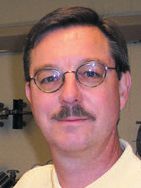Where are all the electrons from?
Drs. Wilfred T. Tysoe & Nicholas D. Spencer | TLT Cutting Edge October 2014
Imaging the distribution of triboemitted electrons in vacuum enables the sources of the electron-emission to be identified.
IN A PREVIOUS TLT COLUMN, we discussed the intriguing observation that X-rays were emitted when Scotch tape was rapidly peeled (
1). However, elementary particles such as electrons also have been detected when surfaces are rubbed. One model for electron emission suggests that they form due to surface fracture during which a charge imbalance between the faces of the cracks produces large electric field gradients, causing electrons to be emitted from the negatively charged crack face. Testing this idea would require knowledge of where the electrons originate.
Drs. Tom Reddyhoff and Julian Le Rouzic from Imperial College in London have solved this problem by incorporating a microchannel plate electron detector in their tribometer. Microchannel plates form the basis of image intensifiers and consist of an insulating plate containing thousands of small holes, much like a sieve. A high voltage is placed across the faces of the plate so that when an electron enters one of the holes and strikes the wall of the hole, it can eject several electrons. The high voltage causes the electrons to be accelerated so that when they hit the wall again, they eject even more electrons.
The stream of electrons that exits the holes after this process has been repeated many times is imaged by a fluorescent screen, as in an old-style television, and produces a much-amplified image of the emitted electron distribution. Reddyhoff and Le Rouzic placed their electron detector facing their tribometer, which was installed in a vacuum chamber to avoid gas effects (
see Figure 1).
 Figure 1.
Figure 1.
The researchers carried out their experiments using a 100-μm-diameter diamond tip sliding at 44 mm/s under a load of 0.4 N on a rotating aluminum disk that had been anodized to form a 5-μm thick oxide film. The electron distributions were measured with a fast camera.
They first carried out a statistical analysis of the total signal produced while rubbing, which revealed that the electron emission was not random—indicating that it must have some deterministic origin. They then examined the electron-emission images as a function of the number of cycles and the angular position on the disk. They found that the largest intensity occurred at the inlet of the contact, suggesting that the electrons were formed by plowing of surface material during abrasion.
However, two other patterns also were observed. The most curious (
see Figure 2) showed straight lines occurring repeatedly at specific disk locations and emanating from the contact at an angle of around 60 degrees to the direction of the wear track. It was suggested that these distributions are caused by cracks formed in or along the wear track, in agreement with the idea that electron emission can occur by charge separation during crack formation.
 Figure 2.
Figure 2.
In the third pattern, an initial burst of electrons from the contact was followed by an emission pattern that rotated with the disk. This emission persisted for more than one second after exiting the contact. This long-time scale is unlikely to be due to propagating cracks and may be due to surface charging.
Being able to resolve triboelectron emission in space and time has revealed the complexity of the process but, at this point, the explanations for the different emission patterns are speculative. However, identifying the positions at which the emission occurs will allow the group to examine those positions using surface analytical techniques to test the speculations. The authors also surmise that imaging electron-emission could provide an in situ approach to monitoring crack formation and growth.
FOR FURTHER READING:
1.
Tysoe, W.T and Spencer, N.D. (2009), “X-rays by Triboluminescence,” TLT,
65 (10), p. 72.
2.
Le Rouzic, J. and Reddyhoff, T. (2014), “Spatially Resolved Triboemission Measurements,”
Tribology Letters,
55 (2), pp. 245-252.
 Eddy Tysoe is a Distinguished Professor of Physical Chemistry at the University of Wisconsin-Milwaukee. You can reach him at wtt@uwm.edu
Eddy Tysoe is a Distinguished Professor of Physical Chemistry at the University of Wisconsin-Milwaukee. You can reach him at wtt@uwm.edu.
 Nic Spencer is professor of surface science and technology at the ETH Zurich, Switzerland. Both serve as editors-in-chief of STLE-affiliated Tribology Letters journal. You can reach him at nspencer@ethz.ch
Nic Spencer is professor of surface science and technology at the ETH Zurich, Switzerland. Both serve as editors-in-chief of STLE-affiliated Tribology Letters journal. You can reach him at nspencer@ethz.ch.